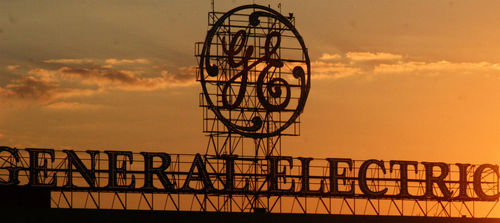General Electric (GE)
General Electric Corporation is one of the largest corporations in the world. Today its business activities span a wide range of areas—everything from aircraft engine manufacturing, appliances, healthcare equipment, and even the NBC television network. As its name implies, however, GE can trace its roots to the early power industry. It was formed in 1892, the result of a merger of the competing companies Edison General Electric Company and the Thomson-Houston Company. The merger was not fully supported by Thomas Edison himself, who withdrew from running the business and returned to the laboratory. Even though Edison was not at the helm, the people at GE adopted one of Edison’s greatest ideas. Following Edison’s example, GE established its first permanent research laboratory in Schenectady, NY, in 1900. This lab has produced a startling number of innovations over the years.
Not surprisingly, GE originally focused on power-industry related items, such as electric lamps, generators, alternators, motors, and other. But even in its early years it began researching other areas, such as radio. GE, American Telephone and Telegraph (AT&T), and the Westinghouse Company were also involved in the creation of the Radio Corporation of America (RCA) in 1919, which became an important player in the field of radio. Years later, these companies would be forced to sell their interests in RCA and let it become an independent company. Then, in 1985, GE again purchased RCA.
In the 1940s GE became a major manufacturer of electric trains. Many inventors had experimented with these from the 19th century on, and there were electric trolley systems in most major cities around the world in the early 1900s. A major shift came after about 1940, when diesel-electric locomotives (which carry a diesel generator to run an electric motor) replaced steam locomotives. GE manufactured many of these large locomotives.
The company was also a manufacturer of vacuum tubes for radios, and of x-ray tubes and complete x-ray machines beginning around 1912. In 1919, a GE researcher invented an important type of tube called the Magnetron, which has been in use for many years in microwave systems.
Beginning in the early 1900s and lasting to the present, GE has manufactured home appliances, including stoves, the “Hotpoint” iron, washing machines, air conditioners, radios, and televisions.
Early in its history, the company began to be involved in technologies that were not strictly electrical. From the 1920s on, for example, GE made superchargers for cars and airplanes, and in 1940 it manufactured an experimental jet engine. The company is today one of the largest manufacturers of military and commercial jet aircraft engines.
Today the company is one of the largest in the world, and owns numerous research and manufacturing firms around the world as well as two television networks and other businesses. The impact that GE has had on engineering is suggested by the fact that GE employees have been granted an astounding 67,000 patents over the years.
